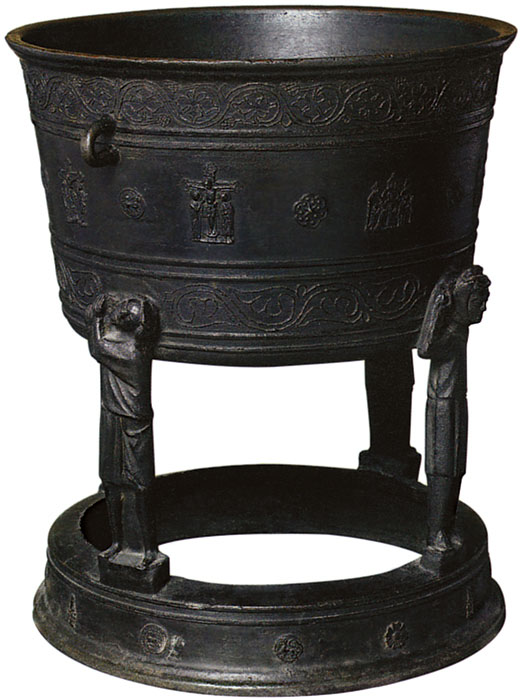Baptismal font, Germany, 14th century.
Bronze, 80.5 x 87 cm. Musée de Cluny, Paris.
It was when Andrea Riccio composed the famous candelabra in the church of Saint Stephen of Padua that Italy admirably entered into the new path of further developing, already susceptible, bronze in more beautiful ways. This solid and majestic architecture with its rich and bold ornamentation, wherein the most graceful scroll-work and foliage form a natural frame for figures, both real and ideal, offered a theme of inexhaustible and endless variety. Candelabra, candlesticks, andirons, bells and boxes were multiplied without repetition. And while figures appeared upon the carved furniture, every accessory vied with each other as masterpieces of art. It is true that the most common utensils invested with this imposing decoration sought, by changing their names, a higher place in the language of the country. Look at that tiny circular temple in the Louvre supported by six pillars, the panels of which are chased and perforated, as is the dome which surmounts it. Simply stated, it is a mortier à cire, most of which are of exquisite workmanship and occasionally topped with charming figurines.
The candlesticks are available in two essentially different types. The most ancient are likely imitations of Persian candlesticks: a conical base supports a flat stand, usually either gadrooned or fluted from the centre, from which arises the baluster-shaped shaft, ending with the holder itself. In others, the stem is simply inserted in a flat stand with mouldings, some of which are supported by three lion claws. Masks, garlands, and scrolls enrich the various parts of this composition.
Shall we speak of these various boxes, some copies from the antique, others flowing in their outlines like marriage-coffers, scent-boxes, writing-desks, innumerable little things which abounded in domestic furniture, and continually sought by amateurs, even today? No, for we should lose ourselves in endless description and, after all, leave much unsaid. One word, however, on the andirons which used to grace those monumental fireplaces of sculptured marble, enriched with Florentine mosaics. Substituted for the huge iron andirons[4] of the Middle Ages, were these of the Renaissance, proportioned in harmony with the surroundings they served to complete. Most frequently the bracket-shaped base with billowing and grotesque masks which served as pedestal for a statue of moderate size and bold design were broad and clever in treatment. The figures were, in almost all cases, borrowed from mythology: Venus, Apollo, Mars, Pluto and sometimes met with personifications of the sun and moon; several of these statues, detached from their bases, still figure in our museums as specimens of the bronze sculptures of the 16th century.
We must, however, examine these ewers with the utmost care, as a number in existence are of French origin and in the purest style of the time of Henry II. The emblems, though a comparative inexperience in bronze workmanship, are indications of their nationality. It is natural to suppose that the example set by Italy was not lost upon French artists, who, to some extent at least, should have followed the example. If the Louvre shows us a charming bell topped with the form of a woman kneeling, then Cluny has preserved another with figures and ornaments signed, Petrus Cheineus me fecit 1573. A French founder, Andrieu Munier, stamped his name upon a bell cast for the church of Poix in Picardy. We will not multiply these examples by descending to the night-lights and other objects of common use, it must suffice that we have drawn the attention of connoisseurs to French Renaissance bronzes and induced them to seek out and collect them.
But it is in the 17th century that bronze, in its application to articles of furniture, assumed paramount importance in France. We find it contributing to the sumptuous adornments of palaces, and vying with the massive goldsmith’s work which was then in vogue. Can the examples of both arts be referred to the same hands? We may suppose it possible when we observe that both start from a common central idea by virtue of the same impulse.
